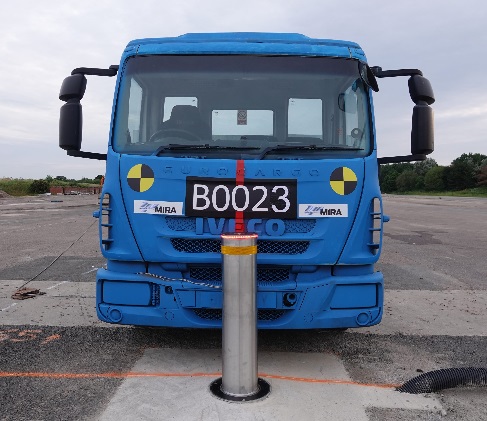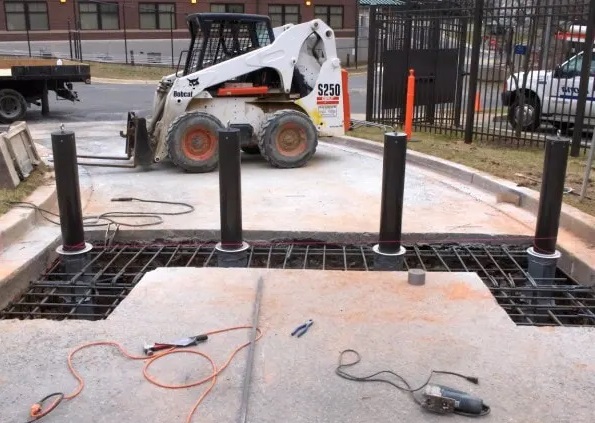Q: What are the crash ratings for bollards?
A: The ASTM standards have replaced DoD standards as the most common standard for crash-testing gate or barrier systems. All crash tests will now be tested under the ASTM F2656 standard.
THE 3 FACTORS THAT DETERMINE CRASH RATINGS
Three basic factors determine crash test ratings:
- The weight of the vehicle
- The speed at which the vehicle is traveling
- The distance the vehicle travels beyond the barrier


The ASTM ratings are judged by the vehicle’s weight and maximum speed on impact with the barrier or crash gate. The P-rating in these standards is the penetration rating described as how far the vehicle will push past the barrier after impact. These are equivalent to the DoD’s L-ratings.
With penetration ratings, the highest-rated barriers will be able to stop vehicles from penetrating in the shortest distance possible. A P-1 rating is the highest level, which denotes that the barrier can stop a vehicle within 3.3 feet of impact or under, P-2 is second at 3.3 feet – 23 feet. The lowest rating is P-3, which encompasses 23.1 feet to 98.4 feet of penetration.

K-RATINGS: OLD METHOD
The Department of Defense (DOD) crash ratings, also known as K-ratings, have been around since 1985 but have been replaced with the updated M ratings that provide more in depth data data.
M-RATINGS: NEW METHOD
The newer M Rating system takes into account a wider range of vehicle weights, speeds and penetration distances than the previous K Rating.
Using standards from the American Society for Testing and Materials (ASTM), ASTM crash ratings are different because they’re based on how far a vehicle’s payload travels beyond a barrier, rather than its front. Like K-ratings, M-ratings are based on vehicle size, speed and travel distance.
M-ratings are also divided into P1, P2, P3 and P4 classifications, based on how far the vehicle traveled beyond the barrier:
- P1 rating: A vehicle traveled 3.3 feet or less beyond the barrier.
- P2 rating: A vehicle traveled between 3.31 and 23 feet.
- P3 rating: A vehicle traveled between 23.1 and 98.4 feet.
- P4 rating: A vehicle traveled farther than 98.4 feet.

Examples of ASTM’s crash barrier ratings:
| Vehicle Type | Weight – up to. | Penetration rating at specific speed. The number refers to vehicle speed in MPH. |
| Small Car (SC) | 2,430 lbs. / 1102 Kg | SC30 (50 kph)
SC40 (65 kph) SC50 (80 kph) SC60 (95 kph) |
| Full Size Sedan (FS) | 4,630 lbs. / 2100 Kg | FS30
FS40 FS50 FS60 |
| Pickup Truck (PU) | 5,070 lbs. / 2300 Kg | PU30
PU40 PU50 PU60 |
| Medium Goods Vehicle (M) | 15,000 lbs. / 6800 Kg | M30
M40 M50 |
| Heavy Goods Vehicle (H) | 65,000 lbs / 26500 Kg | H30
H40 H50 |
ASTM penetration levels:
| P1 | Penetration up to 3.3 feet (1 m.) |
| P2 | Penetration up to 23 feet (7 m.) |
| P3 | Penetration up to 98 feet (30 m.) |
| P4 | Penetration greater than 98 feet (30 m.) |